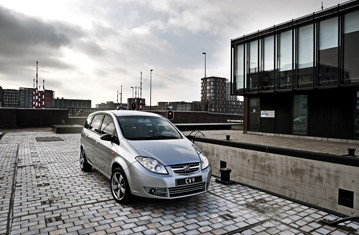Find more information in the General Comments section of the assessment
Find more information in the Rating Validity tab of the assessment
- See More
- See More
- See More
- See More
- Good
- Adequate
- Marginal
- Weak
- Poor
 Passenger
Passenger
 Driver
Driver
 Front Seat
Front Seat
 Car
Car
 Pole
Pole
- Good
- Adequate
- Marginal
- Weak
- Poor


Passenger
outboard
center
Fitted to the vehicle as standard
Not fitted to the test vehicle but available as option
Not Available
In the frontal impact, forward movement of the head of the 3 year dummy, sat in a forward facing restraint, exceeded recommended limits. However, in the side barrier test, both the 3 year and the 18 month dummies were properly contained within the protective shells of their restraints. The passenger airbag cannot be disabled to allow a rearward facing restraint to be used in that seating position and the label warning of the dangers of doing so was unclear and not permanently attached. Markings on the restraints of both dummies were not permanently attached and points were lost.
- Good
- Adequate
- Marginal
- Weak
- Poor

Head Impact 7.4 Pts
Pelvis Impact 0.0 Pts
Leg Impact 3.9 Pts
The protection offered by the bumper to pedestrians' legs was good in places and poor in others. The front edge of the bonnet offered poor protection and scored no points in Euro NCAP's tests. Tests in some areas at the centre of the bonnet indicated good protection for a child's head but was poor elsewhere. The protection offered to the head of a struck adult was also predominantly poor.
- Good
- Adequate
- Marginal
- Weak
- Poor
| Applies To | Front seats | ||
| Warning | Driver Seat | Front Passenger(s) | Rear Passenger(s) |
| Visual | |||
| Audible | |||
|
|||
A seatbelt reminder system is standard equipment for the driver and front passenger seats. Electronic stability control is not currently available on the CV9.
- Specifications
- Safety Equipment
- Videos
- Rating Validity
Specifications
Tested Model Landwind CV9 2.0, LHD
Body Type - 5 door MPV
Year Of Publication 2010
Kerb Weight 1420kg
VIN From Which Rating Applies - See comments.
Class Small MPV
Safety Equipment
Note: Other equipment may be available on the vehicle but was not considered in the test year.
Fitted to the vehicle as standard
Fitted to the vehicle as option
Not fitted to the test vehicle but available as option
Not Available
Not Applicable
Videos
Rating Validity


Find more information in the General Comments section of the assessment
The CV9 is not currently available in Europe although customer orders are being taken and the first cars will arrive soon. The vehicles tested by Euro NCAP were early examples of European cars. Euro NCAP understands that Landwind intends to import vehicles of this specification into Europe in early 2011.
 Share
Share









Inspection of the vehicle after the frontal impact, and examination of its performance during the test itself, revealed that structures surrounding the passenger compartment were at the limit of their load-bearing capacity. As a result, the passenger compartment was deemed to be unstable as an impact at a higher speed was expected to lead to significantly greater collapse. Protection of the driver's chest was rated as marginal. Dummy readings indicated good protection of the front seat occupants' knees and femurs. However, structures in the dashboard presented a risk of injury to occupants of different sizes and to those sat in different positions, and protection was rated as marginal. The steering rack was pushed rearwards during the frontal test, heavily distorting the driver's footwell and tearing the metal. This represented a risk of injury to the driver's feet and ankles and the car was penalised. The CV9 has no side protection airbags and, in the side barrier test, protection of the chest area was rated as weak and that of the abdomen as marginal. In that test, three doors were seen to have opened during the impact. Landwind have attributed this to weak springs in the door latches and intend to fit stiffer springs to try to overcome the problem in future vehicles. As the car has no head protection device, no side pole test was performed. The seats supplied for whiplash tests were not consistent with the ones in the test vehicles. As the seats in the test cars were damaged from the full scale tests, no valid assessment could be made of the whiplash protection offered by the CV9.